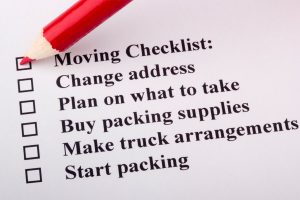
 Write everything down! You’ll thank yourself later. Before you pack even one box, create a simple record keeping system. Create a computer-printed list of numbers with a space to write the contents, have a notebook for the job. You’ll place a number on each box you pack and list the contents on your list. Don’t put the list down unless it’s in a place you’ll call Moving zone. This is where you’ll find your labels, marking pens, box tape, and other supplies. When describing the box contents, be specific — “A-D files” is better than “paper work, and “Aunt Lucie’s dishes” rather than “misc. kitchen”
Write everything down! You’ll thank yourself later. Before you pack even one box, create a simple record keeping system. Create a computer-printed list of numbers with a space to write the contents, have a notebook for the job. You’ll place a number on each box you pack and list the contents on your list. Don’t put the list down unless it’s in a place you’ll call Moving zone. This is where you’ll find your labels, marking pens, box tape, and other supplies. When describing the box contents, be specific — “A-D files” is better than “paper work, and “Aunt Lucie’s dishes” rather than “misc. kitchen”

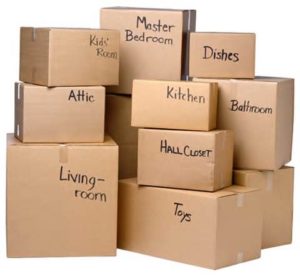 Please pack books in their proper boxes 1.5 is a book box ….not bags, medium or large boxes is inappropriate and unacceptable. It is to much on the movers to lift bags of over stuffed items. Such as: weights,books,trophies,dvds, magazines these items do not go in bags!
Please pack books in their proper boxes 1.5 is a book box ….not bags, medium or large boxes is inappropriate and unacceptable. It is to much on the movers to lift bags of over stuffed items. Such as: weights,books,trophies,dvds, magazines these items do not go in bags!
No glass against glass please wrap these items with packing paper or newspaper …it must feel like a pillow in your hand before placing it in the box…The movers have an option not to move any item that is not packed properly.

You’ll need a lot of boxes–probably more boxes than you imagine, and having enough boxes will make your life easier! Keep at least: 15-20 different variety set aside to use for last minute items on moving day, such as bedding, clothing, and cleaning supplies. You will have to make sure to close up the boxes securely. Use unprinted newsprint (newspaper can stain your items) or packing paper or bubble wrap to wrap and cushion household goods.
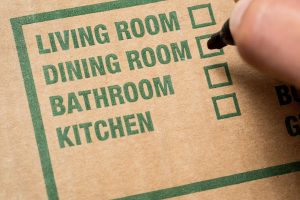
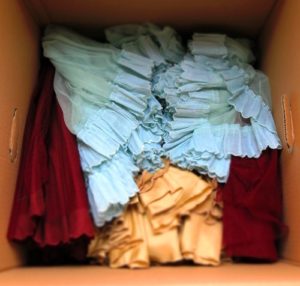 They are perfect for bulky and lightweight items such as comforters, pillows, and blankets, as well as clothes that need to remain hanging. Measure the clothes in your closets (including coat closets) to see how many wardrobe boxes you’ll need. You can also use them for closet storage boxes, shoe boxes, and other bulky items such as fabric bolts, large baskets, or gift wrap tubes.
They are perfect for bulky and lightweight items such as comforters, pillows, and blankets, as well as clothes that need to remain hanging. Measure the clothes in your closets (including coat closets) to see how many wardrobe boxes you’ll need. You can also use them for closet storage boxes, shoe boxes, and other bulky items such as fabric bolts, large baskets, or gift wrap tubes.

 Dream Team will be happy to deliver all the materials you’ll need on your moving day. If you’re doing the move yourself with your own truck, you should try to get things organized as early as possible. A few days before your move, fill some sturdy handled shopping bags with bulky closet items such as shoes, sweaters, belts, and jeans. On moving day, fill the bottom of the wardrobe boxes with some of the shopping bags, then add your hanging clothing. Pack hanging items tightly so things won’t move around and fall off of hangers. Finally, cover the shoulders of your clothes (a dry cleaning bag works well), then add a few purses or sweaters on top. You’ll have fewer boxes, and closet items remain together. Also, the shopping bags will make it easier to retrieve your belongings from the bottoms of a tall wardrobe box. ” PACKING TIPS MOVING “
Dream Team will be happy to deliver all the materials you’ll need on your moving day. If you’re doing the move yourself with your own truck, you should try to get things organized as early as possible. A few days before your move, fill some sturdy handled shopping bags with bulky closet items such as shoes, sweaters, belts, and jeans. On moving day, fill the bottom of the wardrobe boxes with some of the shopping bags, then add your hanging clothing. Pack hanging items tightly so things won’t move around and fall off of hangers. Finally, cover the shoulders of your clothes (a dry cleaning bag works well), then add a few purses or sweaters on top. You’ll have fewer boxes, and closet items remain together. Also, the shopping bags will make it easier to retrieve your belongings from the bottoms of a tall wardrobe box. ” PACKING TIPS MOVING “

 Designate a color for each room in the new home, such as purple for kitchen, green for living room, etc. Apply colored stickers on the box near the box number. In your new home. Put a matching sticker on the door to each room. The movers will know where to put everything when they arrive at the destination. It’s also helpful to post a big sign on the wall in the room where you want boxes stacked, (“Boxes here please”) to keep them out of furniture and traffic areas.
Designate a color for each room in the new home, such as purple for kitchen, green for living room, etc. Apply colored stickers on the box near the box number. In your new home. Put a matching sticker on the door to each room. The movers will know where to put everything when they arrive at the destination. It’s also helpful to post a big sign on the wall in the room where you want boxes stacked, (“Boxes here please”) to keep them out of furniture and traffic areas.
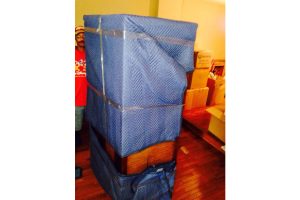
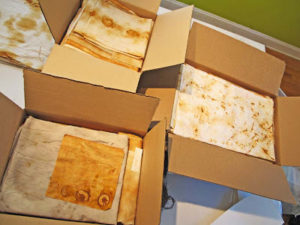 Insist on keeping things together when you or the movers are packing . Keep bookends with books, light bulbs with lamps, and extension cords with appliances. Small, loose parts can be attached to the item they belong to with tape or placed in small envelopes — to keep picture hooks with pictures, shelf brackets with a bookcase, a special wrench and bolts with the wall unit. Keep larger corresponding items (such as a cable TV cord) in resealable bags, and tape these to the underside or back of the item. As a backup, have a “Parts Box” open on the kitchen counter and fill it with cables, cords, parts, pieces, brackets, or nails that are removed from any items of furniture. Keep this box with you, or mark it well with a rainbow of colored stickers so it can be easily located on move-in day.
Insist on keeping things together when you or the movers are packing . Keep bookends with books, light bulbs with lamps, and extension cords with appliances. Small, loose parts can be attached to the item they belong to with tape or placed in small envelopes — to keep picture hooks with pictures, shelf brackets with a bookcase, a special wrench and bolts with the wall unit. Keep larger corresponding items (such as a cable TV cord) in resealable bags, and tape these to the underside or back of the item. As a backup, have a “Parts Box” open on the kitchen counter and fill it with cables, cords, parts, pieces, brackets, or nails that are removed from any items of furniture. Keep this box with you, or mark it well with a rainbow of colored stickers so it can be easily located on move-in day.

 Anything you can pack ahead will save you time on moving day. If it’s summer, get your winter clothes out of the way. You don’t really need 7 radios or TV’s around your house for the last few days there. Box up your shampoo and extra toothpaste and live out of a travel cosmetic case for the last week or two. Pare down cooking utensils and food supplies to bare essentials. Wastebaskets can also be packed (put things in them!) while you switch to using plastic grocery bags {Please pack boxes tight and secure …..nothing loose inside please
Anything you can pack ahead will save you time on moving day. If it’s summer, get your winter clothes out of the way. You don’t really need 7 radios or TV’s around your house for the last few days there. Box up your shampoo and extra toothpaste and live out of a travel cosmetic case for the last week or two. Pare down cooking utensils and food supplies to bare essentials. Wastebaskets can also be packed (put things in them!) while you switch to using plastic grocery bags {Please pack boxes tight and secure …..nothing loose inside please
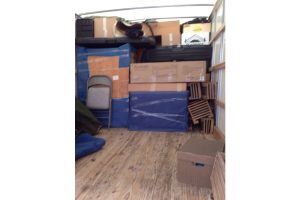
 If you must clean your old place after moving out, put together a kit of basic cleaning supplies and rags. Clean anything possible ahead of time (the inside of kitchen cupboards, the oven, windows, etc.), and if possible, vacuum each room as movers empty it.
If you must clean your old place after moving out, put together a kit of basic cleaning supplies and rags. Clean anything possible ahead of time (the inside of kitchen cupboards, the oven, windows, etc.), and if possible, vacuum each room as movers empty it.

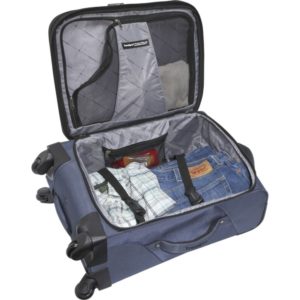 Fill luggage and duffel bags with clothing, sheets, towels, and paper goods. Even for local moves you’ll be able to quickly spot your favorite suitcase holding your rugby shirts, in some cases box” 49″ might remain elusive for days.
Fill luggage and duffel bags with clothing, sheets, towels, and paper goods. Even for local moves you’ll be able to quickly spot your favorite suitcase holding your rugby shirts, in some cases box” 49″ might remain elusive for days.
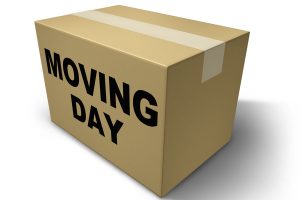
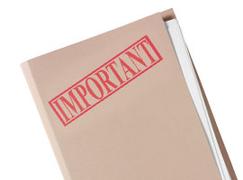 Your list of “important” papers might include: birth certificates, school records, credit receipts, social security card, recent bank records, current bills, phone lists, closing papers, realtor info, and more. Don’t leave these with the movers. Keep them with you!
Your list of “important” papers might include: birth certificates, school records, credit receipts, social security card, recent bank records, current bills, phone lists, closing papers, realtor info, and more. Don’t leave these with the movers. Keep them with you!

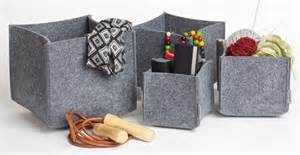 Use brightly colored storage tote boxes, one for each person. Let each family member fill theirs with items they’ll want ‘right away’ in the new home — a set of sheets, a towel, a couple of extension cords, a phone, nightlights, address book, pens and paper, keys, Kleenex, and travel cosmetic case, and so on.
Use brightly colored storage tote boxes, one for each person. Let each family member fill theirs with items they’ll want ‘right away’ in the new home — a set of sheets, a towel, a couple of extension cords, a phone, nightlights, address book, pens and paper, keys, Kleenex, and travel cosmetic case, and so on.

